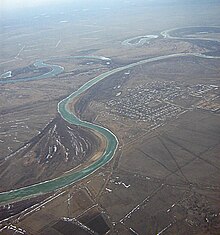Yaik
| Ural River | |
|---|---|

|
|
 |
|
| Country | Kazakhstan, Russia |
| Basin | |
| Main source | Ural Mountains |
| River mouth | Caspian Sea |
| Basin size | 231,000 km2 (89,000 sq mi) |
| Physical characteristics | |
| Length | 2,428 km (1,509 mi) |
| Discharge |
|
The Ural (Russian: Урал, pronounced [ʊˈrɑl]) or Jayıq/Zhayyq (Bashkir: Яйыҡ, Yayıq, يايئق pronounced [jɑˈjɯ̞q ], Kazakh: Жайық, Jayıq, جايىق, pronounced [ʒɑjə́q]), known as Yaik (Russian: Яик) before 1775, is a river flowing through Russia and Kazakhstan in Eurasia. It originates in the southern Ural Mountains and ends at the Caspian Sea. At 2,428 kilometres (1,509 mi), it is the third-longest river in Europe after the Volga and the Danube, and the 18th-longest river in Asia. The Ural River is conventionally considered part of the boundary between the continents of Europe and Asia.
The Ural River arises near Mount Kruglaya in the Ural Mountains, flows south parallel and west of the north-flowing Tobol River, through Magnitogorsk, and around the southern end of the Urals, through Orsk where it turns west for about 300 kilometres (190 mi), to Orenburg, when the Sakmara River joins. From Orenburg it continues west, passing into Kazakhstan, then turning south again at Oral, and meandering through a broad flat plain until it reaches the Caspian a few miles below Atyrau, where it forms a fine digitate delta at (46°53′N 51°37′E / 46.883°N 51.617°E).
...
Wikipedia
